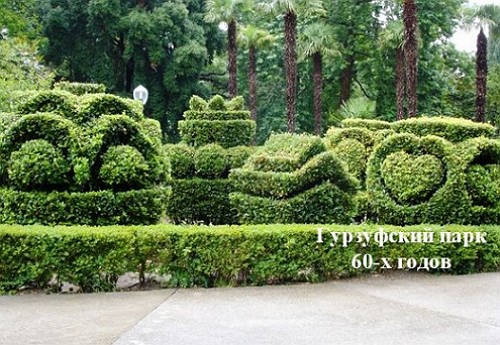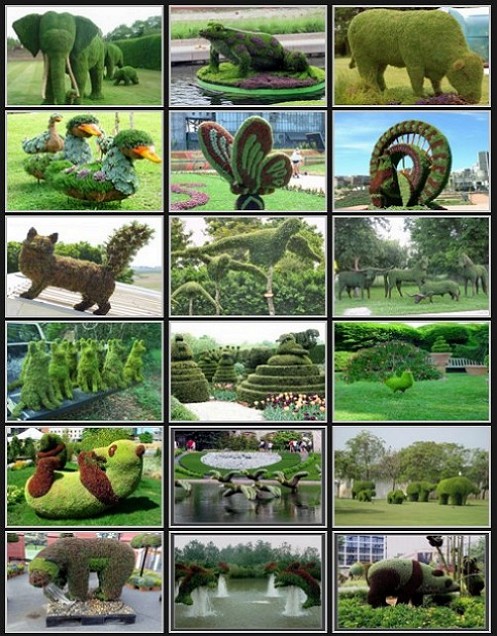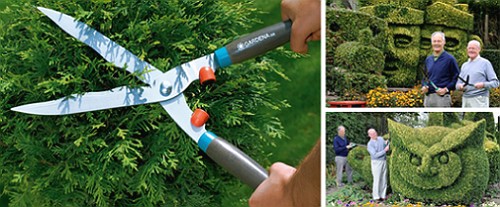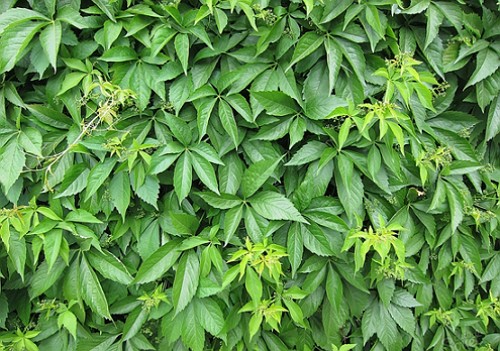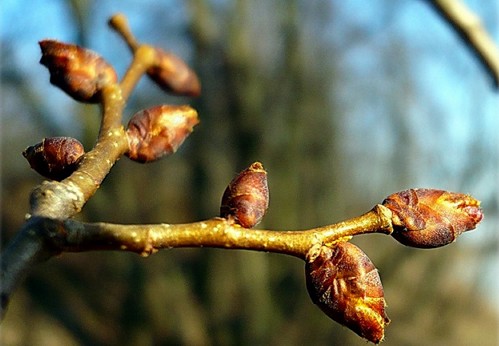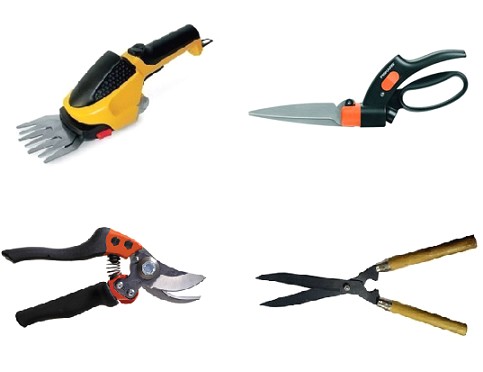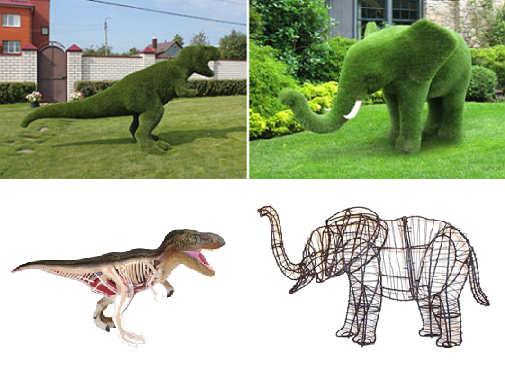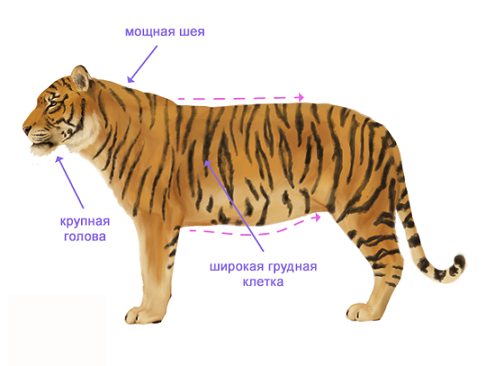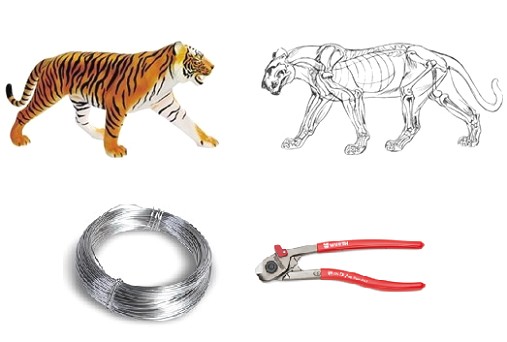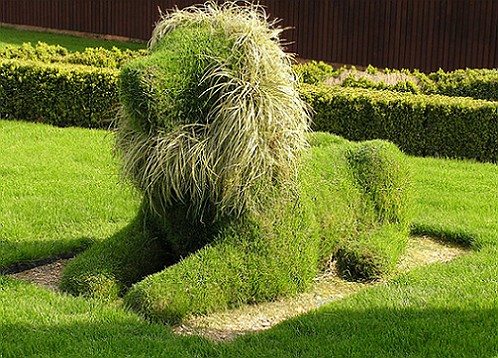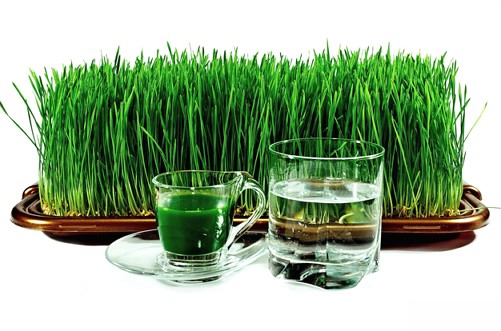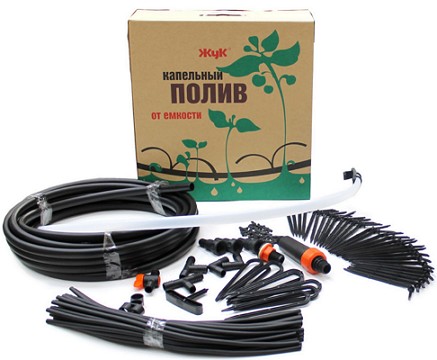The ideal way to show the world their own creative abilities and assert themselves is the creation of garden figures and sculptures. For this, it is not necessary to finish the artist or be an advanced designer. A little imagination, proper care and shearing of plants in the near future will provide your garden with a park of exotic animals and green sculptures remotely resembling the look and shape of a beloved woman.
Content
From Gurzuf to Kamchatka we will cut the bushes smoothly
The figured cutting of bushes and trees, like art, its roots in the literal and figurative sense goes back to the time of the Roman Empire. The first element, cut with the clever hands of a gardener in the form of a cube or a ball, was the godfather of the garden topiary.
The most beautiful garden areas are now impossible to imagine without original and expressive figures in the form of geometric volumes, architectural structures or funny animals. Today, the fashion for topiary from flowers or plants is at its peak. But to master the techniques and techniques of curly haircut, you need patience and imagination, as well as love and time.
The first timid attempts to create something similar in Gurzuf Park were clumsy and inexpressive. Something was missing when creating the figures: whether the gardener was afraid to cut excess, or lacked a violent imagination and the embodiment of his ideas. If you fully possess all these qualities, or strive to acquire them, then this kind of landscape art for you!
But the imagination of the newly-made gardeners of the topiary does not know the boundaries in the cottages and landscaped areas. Today, magnificent figures can be seen not only in the boring parks of the Jurassic period. How to become a real toriarium?
Topiari techniques or how to make a green beast
There are several techniques for creating topiari. This is frameless and wireframe technology.
frameless technique
Frameless technology is based on manual cutting of shrub plants with garden scissors. With frameless technology, the accuracy of cutting and creating the required volume depends on the skill and skill of the gardener. With frameless technology, a suitable plant should be selected in order for the possibility of an overgrown crown to influence the choice of the shape of the desired shape. In many ways, this depends on the type of plant and the density of the foliage, its length and the shape of the leaflets. We will suggest that for the creation of a beautiful topiary or a fence, it is preferable to use thuju, boxwood, birch (Ligustrim) and conifers.
every gardener wants to know
Not all plants and shrubs are suitable for making topiary. This should be plants with hard and fast-growing leaves, such as thuja and boxwood. Thuya is a genus of evergreen conifers and shrubs of a small height of cypress family. There are several types of thuya that are suitable for making topiary.
Boxwood is also a representative of evergreen shrubs and has about 40 species. Boxwood is a shrub up to 12 m high with leafy shoots. Leaves of the sedentary form come in different sizes. Plant a box in the spring and during rooting the first haircut of the leaves is performed. With timely watering and spraying of shrubs, it does not stop the growth of shoots, which provides a dense green crown.
Biryuchina is a genus of shrub plants of the olive family and has 40 species.
For sculptures and figures, climbing plants are used, namely: quinquinia abernia, common ivy, roundwood leopard, girlish triostric and five-leaved grapes. The duration of the green cover determines the climate of the locality and the plant variety for the topiary with the possibility of wintering.
Useful tips: choose plants for topiary
For the self-creation of forms and sculptures, preference is best given to plants with small leaves that are able to form replacing shoots throughout the growing season. Not bad, if on a branch there will be a set of living sleeping buds, ready for the subsequent growth of foliage. Now it's up to the right choice of the instrument for cutting the plants.
tool for a hairstyle
The workshop of this topiary should have in its arsenal a powerful tool - a tool for cutting the leaves. By what criteria should you choose a tool for a hairstyle?
For daily care of figures and shrub sculptures, a minimal set of tools is required, which is represented by sharply sharpened trellis (garden) scissors, secateurs (straight and side), and a sawcut and saw.
Care with the use of the tool assumes regular alignment of the crown with clipping of growing shoots along the semantic load of the plant. In addition, care involves watering and fertilizing the plant.
wireframe technology
Wireframe technology is fundamentally different from the curly hairstyle.
Having mastered the technique, you can confidently answer the question: "How to make a topiary with your own hands." In the topiary frame technology, the technique is used to fill the frame of the figure with soil and subsequent planting into the framework of vegetation.
The process of creating a figure or sculpture consists of the stages:
• selection of the location of the figure and the plant
• creation of a breadboard model and wireframe
• filling the frame with soil
• planting of vegetation in the filled frame.
The basis of the topiary frame is a homemade or purchased ready-made wire frame. Using a skeleton, create complex sculptural forms and desktop tiny compositions.
Any step-by-step topiari on wireframe technology begins with a sketch of the wireframe and embodies the idea in a mock-up of cardboard. Modeling will allow to make adjustments to the image of the sculpture and eliminate modeling errors.
carotid anatomy
The anatomy of the carcass should match the idea of the figure. Let's say that if a hare is indicated, then the accent should be strengthened on the long ears, and if it's an elephant - then on the trunk and tail. The long hind legs of the hare are anatomically perfect for the elephant and vice versa. There was also a novelty in topiary - animals with lamps.
Imagine a lynx or a tiger, standing on two hind legs and holding a lamp in the front. Therefore, it is necessary to transfer in the frame all the dynamics of the green beast.
Then the wireframe is assembled from the wire, taking into account the possibility of stratification to the formation of bulk. At the intersections, the wire is fixed by welding, ensuring the stability of the sculpture. The finished frame is braided with a grid with cells no more than 10 mm.
Useful tips: we collect the soil for filling
Soil mixture for the contents of the carcass is carefully selected. In one tank mix nutrient mixture and soil, consisting of leaf land, turf and top layer of peat. Then, finely chopped straw is added to the resulting mass. Thanks to the presence of straw and moistening of the soil mixture, the latter will not get enough sleep out of the frame. Then the balls are made from the mixture and placed in a frame container.
How to fill the frame with primer is shown here.
landscaping filling
The final stage in the creation of the frame topiary is the planting of the filler. The filler is populated with plants in the order in which they subsequently grow. This means that initially planted a "culture", and then a lawn. For example, to create an imitation of lion skins, initially sprouted seeds were introduced into the soil mixture, and then for the mane - a lawn mixture with long stems.
Let's tell that to fill a skeleton with a gardening begin with fine details - a tail, ears, a beak and extremities. Planting technology is as follows: in the lump of the mixture a sharp object is made deepening to a depth in which seeds or plants with roots will fit.
After such an injection, the groove is closed and tamped with moss.
Each skeleton figure is equipped with support posts and platforms, thanks to which the frame, filled with soil mixture, stably stands on a conventional place.
For the convenience of maintenance of the structure, a drip irrigation system is thought through and carried out. Tubes have a frame for uniform irrigation, facilitating the care of the original and picturesque object of the suburban area - for topiari.





